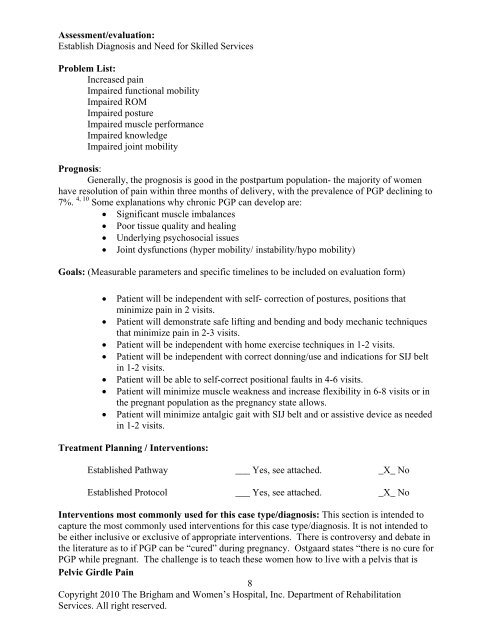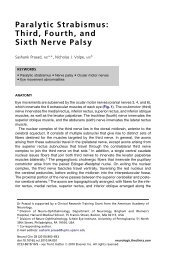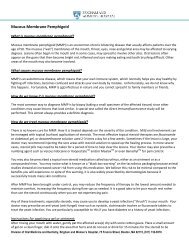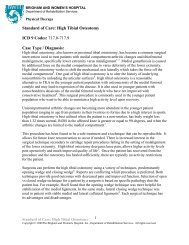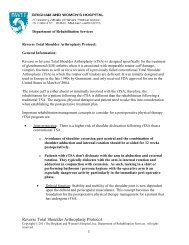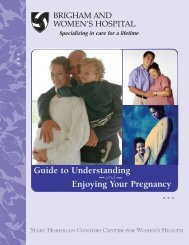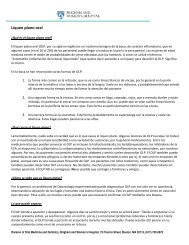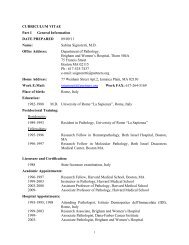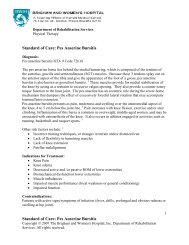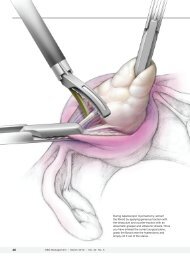Pelvic Girdle Pain - Brigham and Women's Hospital
Pelvic Girdle Pain - Brigham and Women's Hospital
Pelvic Girdle Pain - Brigham and Women's Hospital
You also want an ePaper? Increase the reach of your titles
YUMPU automatically turns print PDFs into web optimized ePapers that Google loves.
Assessment/evaluation:<br />
Establish Diagnosis <strong>and</strong> Need for Skilled Services<br />
Problem List:<br />
Increased pain<br />
Impaired functional mobility<br />
Impaired ROM<br />
Impaired posture<br />
Impaired muscle performance<br />
Impaired knowledge<br />
Impaired joint mobility<br />
Prognosis:<br />
Generally, the prognosis is good in the postpartum population- the majority of women<br />
have resolution of pain within three months of delivery, with the prevalence of PGP declining to<br />
7%. 4, 10 Some explanations why chronic PGP can develop are:<br />
• Significant muscle imbalances<br />
• Poor tissue quality <strong>and</strong> healing<br />
• Underlying psychosocial issues<br />
• Joint dysfunctions (hyper mobility/ instability/hypo mobility)<br />
Goals: (Measurable parameters <strong>and</strong> specific timelines to be included on evaluation form)<br />
• Patient will be independent with self- correction of postures, positions that<br />
minimize pain in 2 visits.<br />
• Patient will demonstrate safe lifting <strong>and</strong> bending <strong>and</strong> body mechanic techniques<br />
that minimize pain in 2-3 visits.<br />
• Patient will be independent with home exercise techniques in 1-2 visits.<br />
• Patient will be independent with correct donning/use <strong>and</strong> indications for SIJ belt<br />
in 1-2 visits.<br />
• Patient will be able to self-correct positional faults in 4-6 visits.<br />
• Patient will minimize muscle weakness <strong>and</strong> increase flexibility in 6-8 visits or in<br />
the pregnant population as the pregnancy state allows.<br />
• Patient will minimize antalgic gait with SIJ belt <strong>and</strong> or assistive device as needed<br />
in 1-2 visits.<br />
Treatment Planning / Interventions:<br />
Established Pathway ___ Yes, see attached. _X_ No<br />
Established Protocol ___ Yes, see attached. _X_ No<br />
Interventions most commonly used for this case type/diagnosis: This section is intended to<br />
capture the most commonly used interventions for this case type/diagnosis. It is not intended to<br />
be either inclusive or exclusive of appropriate interventions. There is controversy <strong>and</strong> debate in<br />
the literature as to if PGP can be “cured” during pregnancy. Ostgaard states “there is no cure for<br />
PGP while pregnant. The challenge is to teach these women how to live with a pelvis that is<br />
<strong>Pelvic</strong> <strong>Girdle</strong> <strong>Pain</strong><br />
8<br />
Copyright 2010 The <strong>Brigham</strong> <strong>and</strong> Women’s <strong>Hospital</strong>, Inc. Department of Rehabilitation<br />
Services. All right reserved.


